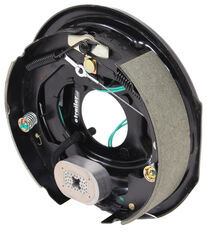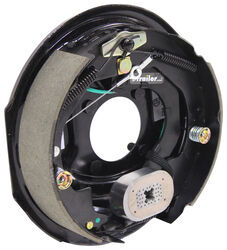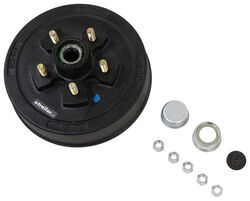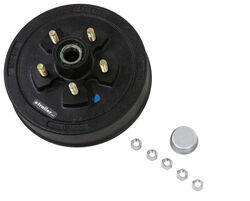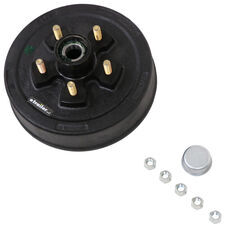
Replacement Brakes and Hub and Drum Assemblies that Use L68149 and L44649 Bearings
Question:
I have a 1984 2-horse trailer. I need to replace the brakes and would like the full assembly on both axles. I have removed a drum to check the bearings, the inner bearing is L68149 and the outer is L44649. The AKHD-5475-35-K brake drums indicate they fit these bearing and also list a 3,500-lb axles with #84 spindles. How can I determine if my axles are 3,500-lb axles with #84 spindles to insure I have the correct drums? I am also looking at the AKEBRK-35L-SA Electric Trailer Brake Assembly - Self-Adjusting - 10
asked by: Brent H
Expert Reply:
The fact that your existing hubs use bearings L68149 and L44649 indicates that the trailer has 84 spindles and the axles are more than likely 3,500 pound axles. The bearing numbers is how we identify things like the correct hubs and capacity so you are good to go.
The bolt pattern the wheels use to secure to the hub and drum assembly is the other key factor. I have included a link that explains how to measure for bolt pattern. The hub you asked about, # AKHD-5475-35-K, has a 5 on 4-3/4 bolt pattern which is not all that common. So determining the bolt pattern is very important.
The most common bolt pattern for hubs that take these bearings is 5 on 4-1/2. Once we have determined the bolt pattern the next step is to determine if you have standard or EZ lube axles. This is easy because if they have a grease fitting at the very end of the spindle (axle) and standard ones do not.
So for example hub # AKHD-545-35-EZ-K has a 5 on 4-1/2 bolt pattern and fits EZ lube axles. The standard counterpart is # AKHD-545-35-K.
The wheel bolt pattern and standard or EZ lube will not apply to the brakes themselves so whatever you end up needing you can use # AKEBRK-35R-SA for the right side and # AKEBRK-35L-SA for the left side.

Products Referenced in This Question
Electric Trailer Brake Assembly - Self-Adjusting - 10" - Left Hand - 3,500 lbs
- Accessories and Parts
- Trailer Brakes
- Electric Drum Brakes
- LH
- 3500 lbs
- Brake Assembly
- Self Adjust
- 10 x 2-1/4 Inch Drum
- etrailer
more information >
Electric Trailer Brake Assembly - Self-Adjusting - 10" - Right Hand - 3,500 lbs
- Accessories and Parts
- Trailer Brakes
- Electric Drum Brakes
- RH
- 3500 lbs
- Brake Assembly
- Self Adjust
- 10 x 2-1/4 Inch Drum
- etrailer
more information >
Easy Grease Trailer Hub and Drum Assembly for 3.5K Axles - 10" - 5 on 4-1/2 - Pre-Greased
- Trailer Hubs and Drums
- Hub with Integrated Drum
- Easy Grease
- EZ Lube
- Pre-Greased
- L68149
- L44649
- For 3500 lbs Axles
- 1/2 Inch Stud
- 5 on 4-1/2 Inch
- 13 Inch Wheel
- 14 Inch Wheel
- 14-1/2 Inch Wheel
- 15 Inch Wheel
- etrailer
more information >
Trailer Hub and Drum Assembly - 3,500-lb Axles - 10" Diameter - 5 on 4-1/2 - Pre-Greased
- Trailer Hubs and Drums
- Hub with Integrated Drum
- Standard
- L68149
- L44649
- For 3500 lbs Axles
- 1/2 Inch Stud
- 5 on 4-1/2 Inch
- 13 Inch Wheel
- 14 Inch Wheel
- 14-1/2 Inch Wheel
- 15 Inch Wheel
- etrailer
more information >
Product Page this Question was Asked From
Trailer Hub and Drum Assembly - 3,500-lb Axles - 10" Diameter - 5 on 4-3/4 - Pre-Greased
- Trailer Hubs and Drums
- Hub with Integrated Drum
- Standard
- L68149
- L44649
- For 3500 lbs Axles
- 1/2 Inch Stud
- 5 on 4-3/4 Inch
- 13 Inch Wheel
- 14 Inch Wheel
- 14-1/2 Inch Wheel
- 15 Inch Wheel
- etrailer
more information >
Featured Help Information
Miscellaneous Media

Continue Researching
- Shop: Dexter Trailer Hub & Drum Assembly for 3,500-lb Axles - 10" Diameter - 5 on 4-1/2 - Pre-Greased
- Shop: Easy Grease Trailer Hub and Drum Assembly - 3.5K Axles - 10" Diameter - 5 on 5 - Pre-Greased
- Shop: Trailer Hub and Drum Assembly - 3,500-lb Axles - 10" Diameter - 5 on 4-3/4 - Pre-Greased
- Shop: Easy Grease Trailer Hub and Drum Assembly for 3.5K Axles - 10" - 5 on 4-1/2 - Pre-Greased
- Video: Bearing Repacking and Grease Seals Installation
- Video: Remove, Inspect, and Reinstall Trailer Bearings, Race, and Seals Demonstration
- Shop: Dexter Trailer Hub and Drum Assembly for 3,500-lb Axles - 10" Diameter - 5 on 4-1/2
- Shop: Dexter Nev-R-Adjust Electric Trailer Brake Assembly - 10" - Left Hand - 3,500 lbs
- Shop: Trailer Hub and Drum Assembly - 3,500-lb Axles - 10" Diameter - 5 on 4-1/2 - Pre-Greased
- Article: Printable Trailer Bolt Hole Pattern Template
- Q&A: How To Measure Bolt Pattern on Wheels or the Wheel Lugs on Hubs for Compatibility
- Video: etrailer Trailer Brakes - Electric Drum Brakes - AKEBRK-35-SA Review
- Search Results: trailer hubs and drums
- Search Results: hubs
- Video: etrailer Pre-Greased Trailer Hub and Drum Assembly Review and Installation
- Video: Review of etrailer Trailer Hubs and Drums - Hub with Integrated Drum - AKHD-5475-35-K
- Video: Review of TruRyde Trailer Spindles - Standard Spindle - TRU59FR
- Video: CE Smith Trailer Hubs and Drums - Hub - CE13110 Review
- Search Results: drum hub
- Search Results: axel
- Search Results: 2000 pound axle
- Search Results: k08~247~90
- Search Results: 023~469~00
- Q&A: Hubs for 3,500 lb Axle with 5 on 4-3/4 inch Bolt Pattern
- Q&A: What Seals Will be the Correct Replacements for an H-1000 Hub?
- Article: Trailer Wiring Diagrams
- Article: How to Measure Your Trailer Wheel Bolt Pattern
- Q&A: Can Electric Brakes be Used on a Boat Trailer
- Article: Parts Needed to Add Electric Drum Brakes to a Trailer
- Article: Most Popular Wheel Bearings



